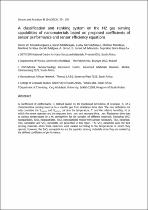 ResearchSpace
ResearchSpace
A classification and ranking system on the H2 gas sensing capabilities of nanomaterials based on proposed coefficients of sensor performance and sensor efficiency equations
JavaScript is disabled for your browser. Some features of this site may not work without it.
- ResearchSpace
- →
- Research Publications/Outputs
- →
- Journal Articles
- →
- View Item
| dc.contributor.author |
Mwakikunga, Bonex W

|
|
| dc.contributor.author |
Motshekga, S

|
|
| dc.contributor.author |
Sikhwivhilu, L

|
|
| dc.contributor.author |
Moodley, M

|
|
| dc.contributor.author |
Scriba, Manfred R

|
|
| dc.contributor.author |
Malgas, G

|
|
| dc.contributor.author |
Simo, A

|
|
| dc.contributor.author |
Maaza, M

|
|
| dc.contributor.author |
Ray, Suprakas S

|
|
| dc.date.accessioned | 2013-11-27T11:54:42Z | |
| dc.date.available | 2013-11-27T11:54:42Z | |
| dc.date.issued | 2013-07 | |
| dc.identifier.citation | Mwakikunga, B.W, Motshekga, S, Sikhwivhilu, L, Moodley, M, Scriba, M, Malgas, G, Simo, A, Maaza, M and Ray, S.S. 2013. A classification and ranking system on the H2 gas sensing capabilities of nanomaterials based on proposed coefficients of sensor performance and sensor efficiency equations. Sensors and Actuators B: Chemical, vol. 184, pp 170-178 | en_US |
| dc.identifier.issn | 0925-4005 | |
| dc.identifier.uri | http://ac.els-cdn.com/S0925400513004218/1-s2.0-S0925400513004218-main.pdf?_tid=225c287e-569a-11e3-9d86-00000aab0f6b&acdnat=1385470755_f10ade55db3d4ab457699ee03614a4c2 | |
| dc.identifier.uri | http://hdl.handle.net/10204/7102 | |
| dc.identifier.uri | https://www.sciencedirect.com/science/article/pii/S0925400513004218 | |
| dc.identifier.uri | https://doi.org/10.1016/j.snb.2013.03.128 | |
| dc.description | Copyright: 2013 Elsevier. This is an ABSTRACT ONLY. The definitive version is published in Sensors and Actuators B: Chemical, vol. 184, pp 170-178 | en_US |
| dc.description.abstract | A coefficient of performance is defined based on the traditional definitions of response, S, of a chemoresistive sensing material to a specific gas from resistance–time data. The new definition not only considers the S(sub response) and S(sub recovery) but also the temperature, T, and the relative humidity, H, at which the sensor operates and the response time, t(subres), and recovery time, t (sub rec). Resistance–time data at various temperatures in a H2 atmosphere for six samples of different materials, including WO(sub3) nanoparticles, SnO(sub2) nanoparticles, SnO(sub2) nanoparticles mixed with carbon nanotubes, TiO(sub2) nanorods, TiO(sub2) nanotubes and VO(sub2) nanobelts, are presented in this report. The VO(sub2) nanobelts were the best sensing materials when these materials were ranked according to the temperatures at which they operate; however, the SnO(sub2) nanoparticles are the superior sensing materials when they are ranked by the defined coefficient of performance. | en_US |
| dc.language.iso | en | en_US |
| dc.publisher | Elsevier | en_US |
| dc.relation.ispartofseries | Workflow;11806 | |
| dc.subject | Nanomaterials | en_US |
| dc.subject | Hydrogen gas sensing | en_US |
| dc.subject | Sensors performance and efficiency | en_US |
| dc.subject | Classification and ranking | en_US |
| dc.title | A classification and ranking system on the H2 gas sensing capabilities of nanomaterials based on proposed coefficients of sensor performance and sensor efficiency equations | en_US |
| dc.type | Article | en_US |
| dc.identifier.apacitation | Mwakikunga, B. W., Motshekga, S., Sikhwivhilu, L., Moodley, M., Scriba, M. R., Malgas, G., ... Ray, S. S. (2013). A classification and ranking system on the H2 gas sensing capabilities of nanomaterials based on proposed coefficients of sensor performance and sensor efficiency equations. http://hdl.handle.net/10204/7102 | en_ZA |
| dc.identifier.chicagocitation | Mwakikunga, Bonex W, S Motshekga, L Sikhwivhilu, M Moodley, Manfred R Scriba, G Malgas, A Simo, M Maaza, and Suprakas S Ray "A classification and ranking system on the H2 gas sensing capabilities of nanomaterials based on proposed coefficients of sensor performance and sensor efficiency equations." (2013) http://hdl.handle.net/10204/7102 | en_ZA |
| dc.identifier.vancouvercitation | Mwakikunga BW, Motshekga S, Sikhwivhilu L, Moodley M, Scriba MR, Malgas G, et al. A classification and ranking system on the H2 gas sensing capabilities of nanomaterials based on proposed coefficients of sensor performance and sensor efficiency equations. 2013; http://hdl.handle.net/10204/7102. | en_ZA |
| dc.identifier.ris | TY - Article AU - Mwakikunga, Bonex W AU - Motshekga, S AU - Sikhwivhilu, L AU - Moodley, M AU - Scriba, Manfred R AU - Malgas, G AU - Simo, A AU - Maaza, M AU - Ray, Suprakas S AB - A coefficient of performance is defined based on the traditional definitions of response, S, of a chemoresistive sensing material to a specific gas from resistance–time data. The new definition not only considers the S(sub response) and S(sub recovery) but also the temperature, T, and the relative humidity, H, at which the sensor operates and the response time, t(subres), and recovery time, t (sub rec). Resistance–time data at various temperatures in a H2 atmosphere for six samples of different materials, including WO(sub3) nanoparticles, SnO(sub2) nanoparticles, SnO(sub2) nanoparticles mixed with carbon nanotubes, TiO(sub2) nanorods, TiO(sub2) nanotubes and VO(sub2) nanobelts, are presented in this report. The VO(sub2) nanobelts were the best sensing materials when these materials were ranked according to the temperatures at which they operate; however, the SnO(sub2) nanoparticles are the superior sensing materials when they are ranked by the defined coefficient of performance. DA - 2013-07 DB - ResearchSpace DP - CSIR KW - Nanomaterials KW - Hydrogen gas sensing KW - Sensors performance and efficiency KW - Classification and ranking LK - https://researchspace.csir.co.za PY - 2013 SM - 0925-4005 T1 - A classification and ranking system on the H2 gas sensing capabilities of nanomaterials based on proposed coefficients of sensor performance and sensor efficiency equations TI - A classification and ranking system on the H2 gas sensing capabilities of nanomaterials based on proposed coefficients of sensor performance and sensor efficiency equations UR - http://hdl.handle.net/10204/7102 ER - | en_ZA |





